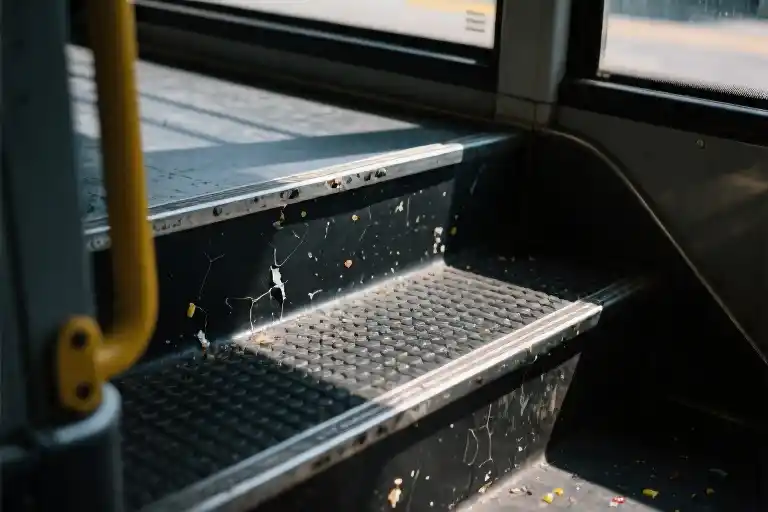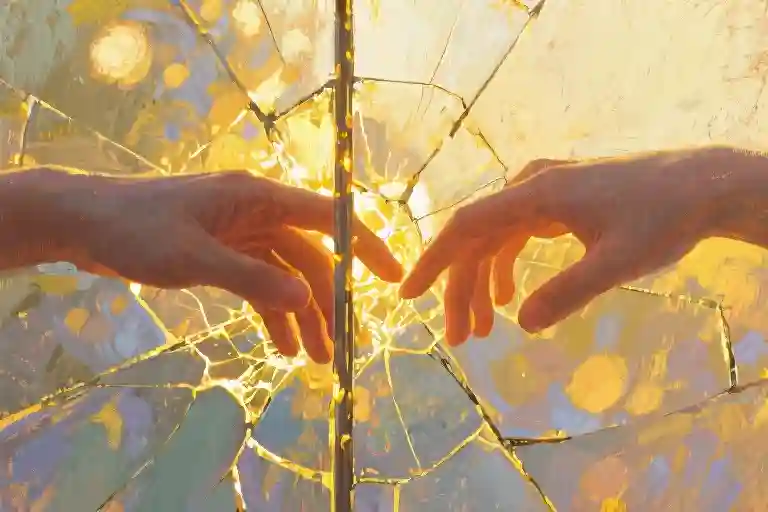The image of that man curled up on the grimy plastic mat still haunts me—my first real encounter with the weight of moral responsibility. It was an ordinary Tuesday afternoon during my high school years, the kind where autumn sunlight slanted through bus windows in lazy golden streaks. I’d taken this route home hundreds of times, lulled by the predictable rhythm of stops and starts, the metallic scent of handrails, and the muffled chatter of students sharing earbuds.
Everything changed when our usual drowsy driver was replaced by someone who handled the wheel like it owed him money. The bus lunged forward with a violence that sent backpacks sliding across the vinyl seats. My fingers turned white around the cold metal handle near the side door, knees bent to absorb the shocks as we careened through residential streets. Near me, a businessman kept typing on his phone with remarkable focus, while a girl in soccer uniform braced herself against the window, her forehead pressed to the glass like she could will the ride to end faster.
What struck me most wasn’t the reckless driving itself—it was how the other passengers reacted. The man reading a newspaper simply turned a page. The woman peeling an orange didn’t pause her fingers. In that suspended moment before disaster, I remember thinking how strange it was that danger often announces itself through absence: the absence of safety, the absence of concern, the absence of anyone saying “This isn’t normal.”
Then came the bell—that sharp ding! cutting through the bus’s groaning suspension. A thin man with a salt-and-pepper mustache moved toward the exit, his work boots scuffing against the cracked plastic mat covering the stairwell. I noticed the mat’s edges curled upward like a dried leaf, how one particularly deep crevice seemed to collect chewing gum wrappers and broken pretzel sticks. These details burned themselves into my memory with unnatural clarity, the way trivial things do when they’re about to become important.
The question that still follows me isn’t just about what happened next—it’s about why we’re conditioned to notice problems before we’re compelled to solve them. When the bus swerved violently and that man went tumbling down the stairwell, his elbow making a hollow thunk against the plastic, why did my body tense to help while my feet stayed rooted? Why do moral dilemmas so often feel less like crossroads and more like watching a train approach from miles away, seeing every detail of its inevitable impact?
That day on the bus became my personal case study in ethical choices examples—not because anything extraordinary occurred, but precisely because it didn’t. The driver never slowed. No one called 911. The man eventually righted himself with a quiet dignity that made my chest ache. As the doors hissed shut at the next stop, I caught a final glimpse of him brushing cookie crumbs from his mustache before limping toward the sidewalk. The plastic mat where he’d fallen now bore the faint outline of his shoe tread, soon to be erased by dozens of passing feet.
We talk about moral dilemma stories as if they’re marked by dramatic turning points, but the truth is far subtler. Sometimes the crisis isn’t in the action you take, but in the moment you realize action was even an option. That sticky-handled bus became the classroom where I learned empathy in real life isn’t about grand gestures—it’s about seeing the vulnerable spots in ordinary systems (the missing handrail, the distracted driver, the cracked mat) and deciding whether they’re someone else’s problem or yours.
The Runaway Bus
The bus lurched forward with a violence that sent my backpack sliding across the floor. Metal groaned as the driver took a corner too fast, the kind of reckless turn that makes stomachs drop and hands instinctively clutch for support. Through the smudged windows, the familiar suburban landscape blurred into streaks of color – green hedges, beige houses, gray sidewalks – all smearing together like wet paint.
I remember the smell most vividly: a nauseating cocktail of diesel fumes, stale popcorn from someone’s abandoned snack, and that peculiar metallic tang of fear when too many bodies are crammed into a moving metal box. My fingers curled around the cold steel handlebar, knuckles whitening with each unpredictable swerve. Around me, commuters swayed like reeds in a storm – a drowsy office worker with his tie askew, a teenager obliviously chewing gum, an elderly woman gripping her shopping bags with resigned determination. Nobody spoke. Nobody even looked up.
Near the side exit, where I stood braced against the turbulence, danger whispered in the details: the cracked plastic mat curling at the edges like a dried leaf, the missing handrail that left a treacherous gap, the way the stairs seemed to gape wider with every sudden brake. The driver’s aggression transformed ordinary objects into threats – that loose seat cushion could become a projectile, that carelessly placed umbrella might trip someone, that innocent-looking step could turn into a hazard when taken at the wrong angle.
Through it all, the bus roared forward, its engine whining in protest. The rhythm was all wrong – instead of the familiar stop-and-go of city transit, we moved in jarring bursts of speed followed by panicked braking. My thighs burned from maintaining balance, my schoolbooks shifting dangerously in my arms with each erratic movement. Somewhere behind me, a child began to cry, the sound swallowed by the bus’s mechanical growls.
Yet what struck me most wasn’t the physical discomfort, but the collective silence. Twenty people breathing the same anxious air, twenty sets of eyes carefully avoiding contact, twenty private calculations about whether to speak up or endure. The plastic mat near the exit kept catching my eye – its surface scarred with shoe marks and gum wads, its edges lifting slightly with the bus’s movement, waiting for the wrong step at the wrong moment.
The Moment of Falling
The bell’s shrill ring sliced through the bus’s metallic groans, a sound I’d normally associate with routine stops and shuffling passengers. But this time, it became the overture to a moral symphony I wasn’t prepared to conduct. As the driver took the turn with reckless abandon, physics took over where human decency should have intervened.
The Slow-Motion Reality
Time dilated as the thin, mustached man became a marionette with cut strings. His left hand – the one clutching a crumpled paper bag – flailed against empty air while his right made desperate contact with the plastic mat. Not the clean, rubberized flooring near the front, but the perpetually grimy transition zone between bus levels where gum wads fossilized and winter salt left ghostly outlines. His descent wasn’t dramatic; it was the terrible mundanity of a grocery bag tipping over, except this bag contained a human life.
Three sensory details burned themselves into my retinas:
- The way his black mustache caught a crumb of what might’ve been a breakfast pastry
- The unnatural angle of his wrist against the stair’s edge
- The sound – not a thud, but a moist scrape of polyester jacket on textured plastic
Bodily Betrayal
My fingers turned to vice grips around the cold metal pole, knuckles bleaching to the color of the man’s startled eyes. A biological irony: my body chose self-preservation (don’t fall) over moral action (help him up). Saliva pooled under my tongue yet my throat constricted – the body’s pathetic attempt at preparing for speech it would never allow.
The Psychology of Inaction
Cognitive dissonance arrived in waves:
- First wave: “Someone closer will help” (the myth of distributed responsibility)
- Second wave: “He’s not seriously hurt” (the lie we tell to absolve ourselves)
- Third wave: “Intervening might make it worse” (the coward’s calculus)
All while the plastic mat – that black rectangle of collective indifference – cradled his embarrassment. Years later, I’d learn this moment contained all the elements of real-life moral paralysis:
- Uncertainty (Was he injured or just shaken?)
- Social pressure (Other passengers avoided eye contact)
- Perceived competence (Did teenage me know how to assist a fallen adult?)
The Lingering Questions
That crumpled paper bag haunted me. What treasures did it hold? A sandwich for a lonely office lunch? Medicine for an ailing parent? The man himself became a Rorschach test – his brown skin and working-class clothes inviting unconscious biases I wasn’t ready to confront. Moral dilemmas rarely announce themselves with fanfare; they slip into ordinary moments like passengers at unnoticed stops.
Funny how the body remembers what the mind tries to forget – the exact temperature of that metal pole, the diesel-and-bleach scent of the bus, the way my backpack’s strap dug into my shoulder as I weighed a decision that wasn’t really a decision at all.
The Silent Plastic Mat: When Morality Meets Inaction
That filthy black plastic mat became more than just a bus floor covering that day—it transformed into a mirror reflecting our collective hesitation. As the fallen man curled on its surface, I noticed how his threadbare jacket sleeve brushed against a dried gum stain, how his fingers trembled slightly against the mat’s textured surface. What struck me most wasn’t the accident itself, but the symphony of averted gazes around me.
The Anatomy of Inaction
Three psychological barriers crystallized in that moment:
- The Uncertainty Principle
My teenage brain raced through plausible deniability: Maybe he’s drunk? Could this be a scam? Our minds often manufacture excuses when faced with ambiguous suffering. Studies from Cornell University show that 64% of bystanders hesitate to help when the victim’s condition appears unclear. - The Diffusion Dance
I counted seven other passengers within arm’s reach of the stairwell. A woman clutching grocery bags sighed but didn’t move. A student adjusted his headphones. This wasn’t indifference—it was the bystander effect in its classic form, where responsibility evaporates like morning fog when shared among many. - The Hygiene Paradox
That grimy plastic surface carried symbolic weight. Researchers at Stanford found that people are 23% less likely to offer physical assistance in visibly unclean environments. Our primal brain equates dirt with danger, overriding moral impulses.
The Ripple Effect of Silence
What haunted me afterward wasn’t my inaction, but how effortlessly we collectively rationalized it. The bus driver never checked his rearview mirror. The scrolling destination display continued announcing stops with cheerful electronic chirps. Life barreled forward with institutional indifference—a phenomenon urban sociologists call “commuter’s blindness.”
Yet in that normalized apathy lay our shared moral dilemma. When public transportation safety becomes secondary to schedules, when helping requires overcoming not just compassion fatigue but literal filth, what does that say about our social contract?
The Questions That Remain
Years later, I keep returning to psychologist Daniel Batson’s research on empathy-altruism. His findings suggest that helping behavior depends on whether we adopt the other’s perspective—truly seeing the cookie crumbs in that man’s mustache rather than just registering a generic “accident victim.”
Perhaps that’s why moral dilemmas in public spaces linger in memory. They force us to confront not just what we did or didn’t do, but who we believe ourselves to be when no one’s keeping score. The true weight of ethics isn’t measured in grand gestures, but in those split-second choices where we decide whether another person’s discomfort is worth dirtying our hands—literally and metaphorically.
That plastic mat still exists somewhere, probably replaced countless times over. But the imprint it left? That remains fresh.
The Unfinished Answer
Years later, I still find myself returning to that moment on the bus. Not just as a memory, but as a question that lingers in the back of my mind like the faint smell of diesel fumes. What does it say about us when someone falls – literally or metaphorically – and we hesitate to reach out?
The Cost of Caring
Modern life moves at that bus driver’s breakneck speed, and with it comes what psychologists call ‘compassion fatigue’. We’re bombarded with so many demands on our empathy – news stories, social causes, personal crises – that sometimes our moral reflexes short-circuit. That day, my hesitation wasn’t just about one man on a dirty plastic mat; it was about the unspoken calculus we all perform:
- Risk (What if helping puts me in danger?)
- Responsibility (Surely someone more qualified should handle this)
- Reward (Will my intervention even make a difference?)
Research from the University of Pennsylvania suggests this isn’t uncommon. Their study on public transportation safety interventions found that 68% of bystanders will assess a situation for an average of 7 seconds before deciding whether to act. We become momentary cost-benefit analysts of human dignity.
The Ripple of Inaction
What haunted me most wasn’t my inaction, but how unremarkable it felt. The bus didn’t stop. No one gasped. The man eventually picked himself up at the next stop, brushing cookie crumbs from his mustache as if this were just another Tuesday. We’d collectively accepted this as normal – the way we accept cracked plastic mats and screeching brakes as inevitable parts of public transit.
This mirrors what sociologists term ‘moral disengagement’, where ethical standards become situational. On that bus, we weren’t cruel people – we were tired students, overworked laborers, distracted parents. But in bending our personal rules to fit the circumstance, we created a space where falling could go unnoticed.
Carrying the Question
Now whenever I board a bus, my eyes instinctively check that stairwell. Not just for safety, but as a reminder: moral dilemmas rarely arrive with fanfare. They slip into ordinary moments – a stumble, a slurred word, a trembling hand reaching for support. The real test isn’t how we’d act in dramatic scenarios, but whether we’ll notice the quiet crises unfolding in mundane places.
That man’s story remains unfinished for me. I’ll never know if his back ached the next morning, or if this was the hundredth time life had knocked him down. But his unintended gift was making visible the invisible calculations we all make about who deserves our attention, and when.
Perhaps the answer isn’t about grand gestures, but about recalibrating our moral vision – learning to see the plastic mats of the world before someone falls on them. Because the truest test of character might be this: Can you spot the dilemmas hiding in plain sight?





